Small-scale farming, large impact on antibiotic resistance

Small-scale meat production operations have direct impacts on the spread and selection of clinically important antibiotics among underdeveloped settings, according to new research.
While small-scale farming in developing countries provides rural communities with important access to protein and income, it may have a large impact on antibiotic resistance.
The researchers from the University of Michigan looked at antibiotic-resistant bacteria populations in farmed broiler chickens, free-range chickens and children in a remote corner of northwestern Ecuador that had until recently had historically low-resistance levels of clinically relevant third-generation antibiotics, such as cefotaxime.
Researchers visited many rural communities in Ecuador’s Esmeraldas province in 2015 and sampled chickens from 10 households raising broiler chickens, which are fed antibiotics and raised in a coop, and backyard breeds, which roam freely inside and outside homes.
They also sampled backyard chickens from 10 household where there was no broiler chicken samples. Two years later, researchers also collected samples from the children in the farming communities.
Gene associated with antibiotic resistance
They uncovered a gene associated with antibiotic resistance – and known to be present in broiler chickens – was also present in backyard chickens and children.
Lead author Hayden Hedman, a doctoral student at the University’s School for Environment and Sustainability, said there was a strong suggestion that the gene was coming from the broiler chickens.
“These findings provide evidence that small-scale meat production operations have direct impacts on the spread and selection of clinically important antibiotics among underdeveloped settings.”
The study, published in the American Journal of Tropical Medicine and Hygiene, found high resistance to cefotaxime, an antibiotic that has clinical importance for both poultry and humans. Of the farmed broiler chickens, 66% had cefotaxime resistance. Backyard chickens showed an increase over time after the broilers’ introduction to the area from about 2% to 18%.
Hedman said more attention needed to be paid to small-scale food animal production and potential spillover events within the surrounding community.
The research is part of a wider, longitudinal study led by Joseph Eisenberg, which is looking to understand how new highways have affected the epidemiology of pathogens causing diarrheal diseases and the spread of antibiotic resistance.












